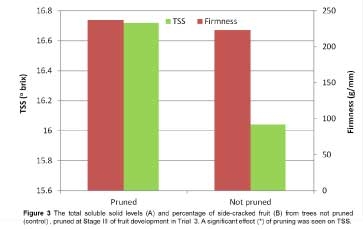Extension growth in cherries (current season leaf growth) occurs throughout the fruit growing season and can be a contributing source of sugars. However, while growing actively they can also require a lot of sugar for their own growth. Hence the question, to cut or not to cut?
Continued from last month
Results
Cracking
Removal of extension growth during rainfall shortly before harvest significantly decreased total and side cracks in Sweetheart.
Cracking was reduced by nearly 50% in one site (Figure 1—see Tree Fruit August 2013).
In each of these trials approximately 11 mm of rainfall occurred in one event.
In another trial using Sweetheart, there was no reduction on cracking when removal of extension growth occurred prior to a rainfall event shortly before harvest.
The timing of removal had an impact on the level of cracking. A significant difference in side cracks was found between times—removal during Stage II of fruit development increased cracking levels at harvest in Sweetheart.
In this trial, rainfall occurred a few days before harvest. However, removal of extension growth during Stage III—about a week before harvest—decreased cracking levels found at harvest (Figure 2—see Tree Fruit August 2013).
No difference in cracking levels was found with removal of extension growth in Satonishiki, but there was an impact on fruit quality.
Sugars
All trials showed that removal of extension growth late during Stage III of fruit development resulted in significantly increased sugar levels in fruit.
This late removal did not result in any differences in other fruit quality parameters such as firmness, size or weight (Figure 3).
However, removal of extension growth at Stage II did not result in any increase fruit sugars by the time harvest occurred. In fact, early removal of extension growth had a negative impact on fruit quality (and cracking) (Figure 4).
Buds
There was no significant effect of removing extension growth on sucrose in the developing buds.
Bud sucrose concentration increased over time (from summer to winter), and sucrose was present in the highest concentration by the onset of dormancy.
High sucrose levels infer cold-hardiness in buds.
The different pruning treatments applied during the summer growing season did not influence the timing or uniformity of spring bud burst or the uniformity of fruit quality the following season.
Summary
The increase in sugar in the current season’s fruit is consistent with other studies investigating carbohydrate allocation.
Demand from various organs can occur simultaneously as would be the case with both developing fruit and developing extension growth.
Strategic shoot pruning alters the allocation of resources sourced through photosynthesis as influenced by leaf area.
Leaf area influences the level of carbohydrates available during the growing season, and removal of leaf area during some periods may result in insufficient levels for allocation to the fruit, potentially lowering fruit quality.
As was seen in this study after early removal of extension growth, new extension growth was induced and was possibly a stronger competitor for sugars during later fruit growth.
Promising results for cracking were seen in this study when pruning occurred during a rainfall event, but this is probably not practical in a commercial orchard.
Pruning earlier in fruit development negatively impacted on fruit quality.
The decision to cut, or not to cut, cannot be easily answered—timing and different impacts need to be considered.
This study did show that any beneficial effects of pruning on current season fruit quality should not impact on future seasons.
For more information contact Penny Measham
Perennial Horticulture Centre
Tasmanian Institute of Agriculture
phone +61 3 62261870
e-mail
This project has been funded by Horticulture Australia Ltd using the cherry industry levy and matched funds from the Australian Government.
See all the tables and graphs in Tree Fruit September 2013






















